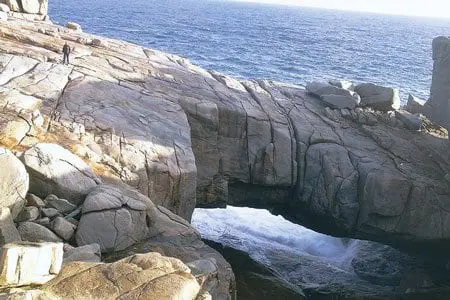Albany, on the south coast of Western Australia, is a popular stopping-place to explore the area’s beauty. A peninsula shelters Albany from the Great Southern Ocean, and is home to the famous ‘Gap’ and ‘Natural Bridge’ rock formations. Interpretive signs in the Torndirrup National Park tell visitors what they are looking at.
One says:
“The continents of Australia and Antarctica were bound together along this rugged coastline for more than one billion years, forming part of the supercontinent Gondwana.”
You can see the coastline and the characteristic granite landscape, with its domed rock outcrops and rounded tors. But you can’t imagine a billion years of time, or how they could measure that value. Nor can you see Antarctica, 3,500 kilometres across the ocean.
iStockphoto.com/Tom_coultas

Granite is often found in large, oval shaped ‘plutons’, 10 or 20 km across. Geologists say plutons took an enormous time to form and cool, as the sign in the park says:
“Pressure and friction at the base of the two fused continents caused rock to melt and slowly rise up through the gneiss [a banded metamorphic rock]. Think of a lava lamp . This molten rock slowly cooled, hardening into granite and helping to cement the continents together.”
“Think of a lava lamp.” Just as the blobs of ‘lava’ rise in the lamp, geologists say enormous ‘balloons’ of molten rock (called diapirs) rose slowly through (yes, through) the earth’s crust. That’s right, the granite balloon, like a single towering body, rose through solid rock—“Slowly, slowly.” This process is said to have taken millions of years.
This idea is often used against the Bible’s 6,000-year timescale of Earth history. Skeptics mock that granite ‘proves’ the Bible chronology is ridiculous. The signs in the national park echo this story, implicitly saying, “The Bible isn’t true.” But why should government agencies promote such a partisan view? Because they rely on science, we are told.

However, geology researchers have long abandoned this balloon idea. They say the scientific consensus has been wrong for a long time. In the Proceedings of the Geologists’ Association, granite expert John Clemens said:
“The long-cherished picture of granitic diapirs slowly pushing their way toward the upper crust and grinding to a halt by solidification has been replaced by an altogether different picture of narrow feeder dykes punching their way upward in months, pulsing with magma and feeding rapidly growing plutons.”1
Instead of millions of years, geologists now say granite plutons form in months. Instead of rising slowly through solid rock, the molten granite punches quickly through long cracks in the crust. That makes much more sense.
Another long-cherished belief overturned by granite research is the idea that the crystals took millions of years to grow. Clemens again:
“Experimentally measured rates indicate that a 5 mm crystal of plagioclase could have grown in as short a time as 1 hour, but probably no more than 25 years.”1
Belief in an old earth has led many to abandon the Bible’s history. Not only that, John Clemens said that belief in an old earth has led geological thinking about granite down the wrong path. He says that granites belong with increasing number of geological processes that were “catastrophic in their suddenness”.
So, the sign in the national park at Albany is wrong. It should say that granites formed catastrophically. That means they did not take much time. And the sign should add that the catastrophe was part of the global catastrophe that impacted the whole earth—the cataclysm of Noah’s Flood (Genesis 6–8).
Related Articles
References and notes
- Clemens, J.D., Granites and granitic magmas: strange phenomena and new perspectives on some old problems, Proceedings of the Geologists’ Association 116:9–16, 2005; p. 15. See also: Walker, T., Granite formation: catastrophic in its suddenness, J. Creation 21(2):13–15, 2007; creation.com/granite. Return to text.







